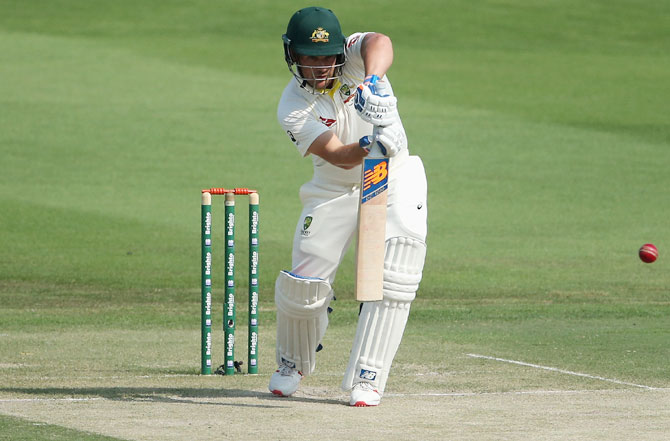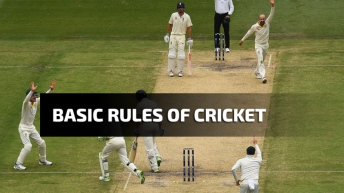Test cricket is the lengthiest form of cricket. It is considered as an ultimate test by players and enthusiastic cricket fans for analyzing the playing strength compare to one-day cricket. Test Match in Cricket is played only among nationally representing teams that select the best players from a specific nation to compete with each other. Here is a complete guide that offers all its aspects for newbies and novices alike.
Moreover, all players in a test match wear white trousers and tees and play with a red ball. Whereas in One-day international cricket and T20 match, players wear colored clothing and play with a white ball.
![Batsman in white clothing hitting the red ball in a Test match]()
In the initial days of one-day matches, the game could involve 50-60 overs, though the standard one-day match has been established at 50 overs for each side for many years that is played in total one day.
T20 is the shortest form of cricket that is played in floodlights. It is played in roughly 3 hours duration inclusive of the short break that occurs in between the two innings.
The trail is opposite to lead, which means the number of runs by which the batting team is behind from the number of runs made by the previously batted team.
In case of losing the ball or disfigurement, before the bowling of 80 overs, no new ball is given instead the umpires must replace it with a comparably worn ball, and both teams are informed regarding this through on-field umpires.
Read also:
After the completion of the first innings, if the opposing team gets dismissed for 200 runs or more, then the first team has the option to make the opposing team straight bat again for the 2nd inning, (enforcing follow-on) or it can also bat itself for gaining a greater lead.
After the enforcing of follow-on, the opposing team bats until it declares or gets dismissed. Now if its score cumulative of both innings is less than the first team’s score from the 1st inning, the first team wins. If it does happen, the first team should bat again in 2nd innings and if it scores more than the opposing team, it wins. Alternatively, if it gets dismissed, then the opposing team wins. Though it is unusual that the team who enforces follow-on loses.
In the case of no enforcement of follow-on the first team bats again till it declares or gets dismissed or the time runs out ( in that case the match gets draw). If the total score of the first team for both innings is less than the opposing team, it loses. Otherwise, the opposing team bats again. Now if their cumulative score gets above the first teams’ score, it wins the match. This explains how a test match is played.
![Bowling Team celebrating the dismissal of the batsmen in Test Cricket]()
Learn more on: ODI Cricket, T20 Cricket.
How is Test Match Different from One-day and T20?
Test cricket differs greatly; let us see how it differs from one-day and T20 cricket match.General Differences
Test Match in Cricket is regarded as the highest level since it demands both physical and mental strength for excelling and is played over 5 days with each team getting 2 innings. One-Day international is limited over the form of cricket where both teams play 50 overs each side. While T20 which is also limited over the game and is the most modern and successful form of cricket offers each team to play 20 overs.Moreover, all players in a test match wear white trousers and tees and play with a red ball. Whereas in One-day international cricket and T20 match, players wear colored clothing and play with a white ball.

Image: Batsman in white clothing hitting the red ball in a Test match (Credit: Gettyimages)
Long Duration
The key difference amongst all these formats of cricket is the respective durations of their games. Test match is played in five days, with every day lasting for six hours along with 90 overs that are bowled each day.In the initial days of one-day matches, the game could involve 50-60 overs, though the standard one-day match has been established at 50 overs for each side for many years that is played in total one day.
T20 is the shortest form of cricket that is played in floodlights. It is played in roughly 3 hours duration inclusive of the short break that occurs in between the two innings.
Rules
Apart from the above-mentioned differences, there are many rules in a test match. Let’s see how these rules will further help you in understanding what is the difference between a test match and a one-day cricket match?The Rules of Test Cricket
Format
The match is given 5 days with each day consisting of 3 sessions and every session comprising of thirty bowling overs.- First Session is played before lunch.
- The second session is played after lunch and before tea.
- The third session is played after tea till the umpire’s declaration of ‘stumps’. This means the end of the play for the day.
Lead and Trail
Lead is a term used technically in test cricket language that shows runs difference by which the team with the greater score is leading from the opposing team.The trail is opposite to lead, which means the number of runs by which the batting team is behind from the number of runs made by the previously batted team.
Declaration
This rule allows the captain for ‘declaring’ the innings, and he can ask the opposing team to bat if he wishes. This is one of the ways for the inning to end the test match, the other being bowling all-out.Follow-on
This rule in test cricket can likely force the second batting team for batting again directly after the completion of their original inning. In a test match, follow on can only occur if the first batting team achieves a lead of a minimum of 200 runs in the first innings. If this occurs, the first batting team's captain has the option to impose the competing team for batting again or he can continue with the original order of the game and make his own team bat.Rules for Bowling
At the beginning of each inning, every team gets a new ball. The bowling team may ask for the new ball after the bowling of 80 overs, and the batsmen are informed regarding this change through the umpires.In case of losing the ball or disfigurement, before the bowling of 80 overs, no new ball is given instead the umpires must replace it with a comparably worn ball, and both teams are informed regarding this through on-field umpires.
Lunch and Tea Break
Since the game is very long, various breaks are given to the players to regain energy after the play session. The duration of the break for lunch and tea 40 minutes and 20 minutes, respectively.Read also:
- T20 Cricket Explained: What You Need To Know About Twenty20 Format
- ODI Cricket Explained: What Is One-Day Match In Cricket?
How is a Test Match Played?
The team that wins the toss chooses to bowl or bat first. It can bat till every batter is out or they can opt to finish batting, like in the case of declaration. Also, there isn’t any limit for batting provided there are minimum 2 batsmen left who haven’t been out.After the completion of the first innings, if the opposing team gets dismissed for 200 runs or more, then the first team has the option to make the opposing team straight bat again for the 2nd inning, (enforcing follow-on) or it can also bat itself for gaining a greater lead.
After the enforcing of follow-on, the opposing team bats until it declares or gets dismissed. Now if its score cumulative of both innings is less than the first team’s score from the 1st inning, the first team wins. If it does happen, the first team should bat again in 2nd innings and if it scores more than the opposing team, it wins. Alternatively, if it gets dismissed, then the opposing team wins. Though it is unusual that the team who enforces follow-on loses.
In the case of no enforcement of follow-on the first team bats again till it declares or gets dismissed or the time runs out ( in that case the match gets draw). If the total score of the first team for both innings is less than the opposing team, it loses. Otherwise, the opposing team bats again. Now if their cumulative score gets above the first teams’ score, it wins the match. This explains how a test match is played.

Image: Bowling Team celebrating the dismissal of the batsmen in Test Cricket (Credit: Gettyimages)
ICC Test Cricket Championship
ICC World Test Championship is a league competition for the test cricket that witnesses the top 9 teams (according to ICC Test Team rankings). This premier championship of test cricket began on August 1st, 2019, and includes Australia, Bangladesh, India, England, New Zealand, South Africa, Pakistan, West Indies, and Sri Lanka that will compete against each other in a total of 71 test cricket matches spanning 27 series across various continents. The championship will be played in 2 years with the final in England in June 2021 among the top two teams.Best Cricket Teams in Test Format
The test format is the ultimate test of teams' strengths and weaknesses. Teams with higher ranks mean they have technically sound players and have bowlers with great skills. Let's see which teams are dominating the test format.| Test Rankings as of 1st January 2020 | ||
|---|---|---|
| Rank | Country | Points Rating |
| 1 | India | 120 |
| 2 | Australia | 108 |
| 3 | England | 105 |
| 4 | New Zealand | 105 |
| 5 | South Africa | 98 |
| 6 | Sri Lanka | 92 |
| 7 | Pakistan | 85 |
| 8 | West Indies | 81 |
| 9 | Bangladesh | 60 |
| 10 | Afghanistan | 49 |
Learn more on: ODI Cricket, T20 Cricket.






















